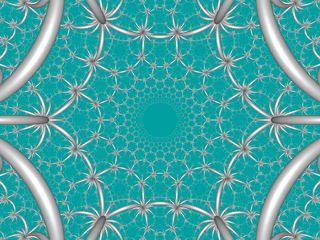| Order-6 hexagonal tiling honeycomb | |
|---|---|
 Perspective projection view from center of Poincaré disk model | |
| Type | Hyperbolic regular honeycomb Paracompact uniform honeycomb |
| Schläfli symbol | {6,3,6} {6,3[3]} |
| Coxeter diagram | |
| Cells | {6,3} |
| Faces | hexagon {6} |
| Edge figure | hexagon {6} |
| Vertex figure | {3,6} or {3[3]} |
| Dual | Self-dual |
| Coxeter group | , [6,3,6] , [6,3[3]] |
| Properties | Regular, quasiregular |
In the field of hyperbolic geometry, the order-6 hexagonal tiling honeycomb is one of 11 regular paracompact honeycombs in 3-dimensional hyperbolic space. It is paracompact because it has cells with an infinite number of faces. Each cell is a hexagonal tiling whose vertices lie on a horosphere: a flat plane in hyperbolic space that approaches a single ideal point at infinity.
The Schläfli symbol of the hexagonal tiling honeycomb is {6,3,6}. Since that of the hexagonal tiling of the plane is {6,3}, this honeycomb has six such hexagonal tilings meeting at each edge. Since the Schläfli symbol of the triangular tiling is {3,6}, the vertex figure of this honeycomb is a triangular tiling. Thus, infinitely many hexagonal tilings meet at each vertex of this honeycomb.[1]
A geometric honeycomb is a space-filling of polyhedral or higher-dimensional cells, so that there are no gaps. It is an example of the more general mathematical tiling or tessellation in any number of dimensions.
Honeycombs are usually constructed in ordinary Euclidean ("flat") space, like the convex uniform honeycombs. They may also be constructed in non-Euclidean spaces, such as hyperbolic uniform honeycombs. Any finite uniform polytope can be projected to its circumsphere to form a uniform honeycomb in spherical space.
- ^ Coxeter The Beauty of Geometry, 1999, Chapter 10, Table III

